
by Sanjukta Chaudhuri
December 2018
Gender and race/ethnicity-based earnings gaps exist even after accounting for field of study and choice of occupation
Obtaining a post-secondary degree tends to lead to better labor market outcomes, including higher income. In Minnesota, median earnings of high school graduates working full-time are $36,000. This increases to $45,000 for associate degree holders, $58,000 for bachelor’s degree holders, and $72,000 for those with five or more years of college. Clearly, on average, post-secondary education increases earnings.
It is not just the degree that matters, however. Field of study is an important factor determining eventual labor market outcomes. According to the American Community Survey, undergraduate degree holders who majored in computer science earn a median salary of $86,000, while graduates of nursing programs earn $73,000, and graduates of early childhood education programs earn $41,000 annually.
Moreover, some programs of study, like nursing, train for very specific occupations while others are not so closely aligned to specific occupations. For example, economics majors find themselves in a variety of occupations, including management, finance, marketing and sales, management analysts, and computer and information research scientists. In this major as well as many others, both occupational choice and educational choice make a difference to lifelong earnings.
In addition to degree level, field of study, and occupation, other factors are associated with earnings. These include gender, race, ethnicity, and immigration status. This article uses ACS one-year microdata from 2012 to 2016 to examine the association between field of study at the bachelor’s level and occupation and earnings by gender and race/ethnicity in Minnesota.
At the bachelor’s degree level, almost a quarter (24.2 percent) of Minnesotans graduated with a business major as their first field of study, making this the most popular general field of study. Business is followed by education administration and teaching (13.2 percent); medical and health sciences and services (7.4 percent); social sciences (6.4 percent), and engineering (6.3 percent). Together, the top five general fields of study explain 57.5 percent of bachelor’s degree holders’ field of study. At the detailed level, 26 percent of bachelor’s degree holders fall into five detailed fields of study: business management and administration (7.3 percent), elementary education (5.2 percent), general business (4.8 percent), nursing (4.7 percent), and accounting (4.3 percent).
There are similarities and differences in field of study by gender. While business, social science, and education administration and teaching are integrated and popular among both men and women, some fields of study are segregated. For example, men tend to favor engineering and computer and information sciences; women favor medical and health sciences and services, and communications. By detailed field of study, accounting and business management and administration both fall into the top five for both men and women. However, men are more likely to choose general business, computer science, and finance, while women are more likely to choose elementary education, nursing, and psychology.
Overall, the choices of fields of study are quite similar between whites and minorities. Both whites and minorities choose business, medical and health sciences and services, social sciences, and engineering. While whites favor education administration and teaching, minorities favor computer and information sciences. At the detailed level, both whites and minorities opt for business management and administration, general business, nursing, and accounting. Whites are more likely to choose elementary education; minorities are more likely to choose computer science.
Predictably, earnings vary by field of study. Figure 1 shows that among the five most popular majors, engineering graduates, ages 25 to 64, earn $84,000 at the median. This is followed by computer and information sciences majors at $80,000, business majors at $65,000, medical and health sciences and services at $62,000, and education administration and teaching majors at $42,000.
These earnings gaps by college major remain stable as workers age. Figure 1 shows the age-earnings profile for four age categories by the five most popular general fields of study. The profiles clearly show that engineering majors are at the top throughout their careers, followed by business, medical and health sciences and services, social sciences, and education administration and teaching majors.
By detailed field of study, accounting and general business majors come out on top with annual median earnings of $70,000 each, followed by nursing at $65,000, business management and administration at $60,000 and elementary education at $40,000. The earnings profiles by age show the same pattern.
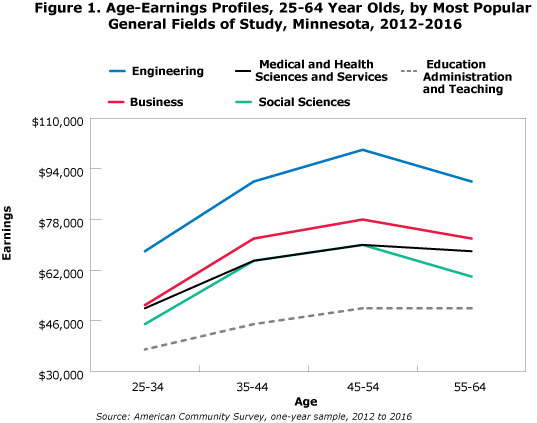
Median annual earnings are stratified not just by field of study, but also by gender and race/ethnicity. Among bachelor’s degree holders only, median earnings are stratified such that males earn more than females, and whites earn more than minorities (Figure 2).
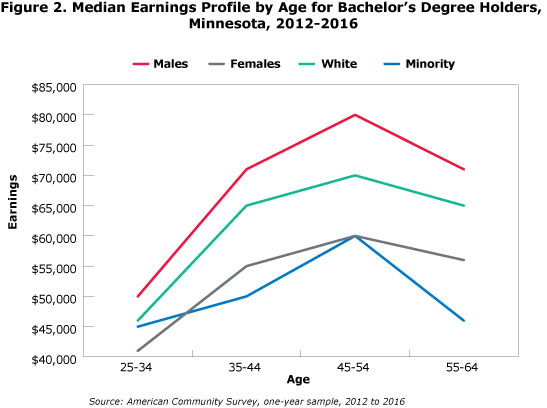
When examined by general field of study, men earn more than women even when they graduate with the same field of study as their college major. Among business, social sciences, and education administration and teaching majors, barring a few exceptions, men invariably earn more than women at the median and also over the age-earnings profile. Even in majors that are more popular among women, such as communications and medical and health sciences and services, men earn more than women. Finally, for majors that are more popular among men, such as engineering and computer and information sciences, men still earn more than women.
Among detailed field of study, men earn more than women at the median with the exception of nursing. The age earnings profiles are also fairly consistent, with women earning less across the four age cohorts examined. Women almost always earn less than men with the same college major.
In terms of race, whites usually earn more than minorities, with a few exceptions (Figure 3). At the high end, in accounting and general business majors, the median annual earnings gap between whites and minorities is $30,000. At the low end, in nursing, the earnings gap between whites and minorities is $6,000. This pattern holds by age.
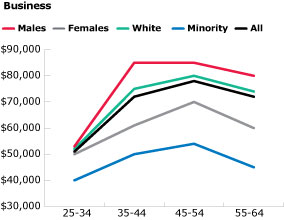 |
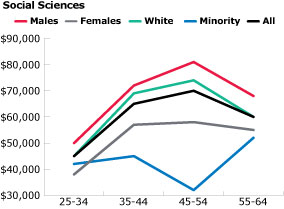 |
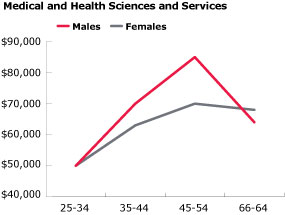 |
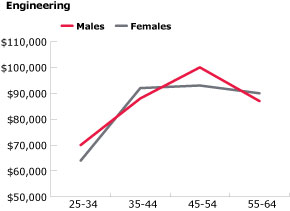 |
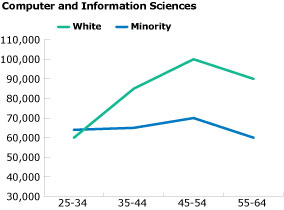 |
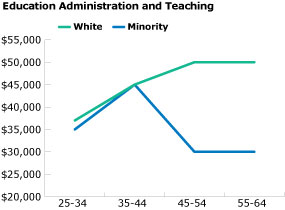 |
| Source:American Community Survey, one-year sample, 2012-2016 | |
Given that gender and race/ethnicity-based earnings gaps persist even when individuals graduate with the same fields of study, it is important to examine to what extent patterns of occupational choices might drive these earnings gaps. Do men and women or whites and minorities make very different occupational choices? Although a conclusive argument cannot be presented, a few case studies can help us approach an analysis.
Accountant and Auditor: Accounting is a popular major among men and women and whites and minorities, and a large proportion become accountants and auditors. Accounting majors (37.8 percent of males, 47.7 percent of females, 44.1 of whites, and 21.1 percent of minorities) choose this occupation making it the top occupational choice for accounting majors. However, men in this occupation earn $80,000 at the median, while women earn $65,000. Similarly, whites working in this occupation earn $72,000 while minorities earn only $42,000.
Software Developer, Applications and Systems Software: Computer science is a field of study particularly popular among minorities. Both whites and minorities who majored in computer science are likely to become software developers, applications and systems software. Specifically, 25.1 percent of white and 33.4 percent of minority computer science majors are found in this occupation. Median earnings for computer science majors are $95,000 for whites and $80,000 for minorities.
Registered Nurse: The nursing major is popular among women and minorities. Predictably, the most popular occupation for nursing majors across the board is registered nursing. Yet, the earnings gap persists. The median wage for men who are registered nurses is $73,000 compared to women at $70,000; white registered nurses earn $70,000 compared to minority registered nurses at $60,000. This finding is supported by past research published in Minnesota Economic Trends which concluded that the earnings gap between white and minority nurses arises from that fact that white nurses are more likely to work in hospitals while minority nurses are more likely to work in nursing homes.
This article finds evidence of gender and race/ethnicity-based earnings gaps in Minnesota, even after accounting for field of study at the bachelor's degree level and eventual occupational choice. To summarize findings, median earnings and earnings over time are stratified by gender, where males earn more than females at all ages, across fields of study and occupation. Similarly, whites earn more than minorities by field of study and occupational choice.
|
Notes on the Data Used for this Analysis This article uses weighted ACS one-year microdata from 2012 to 2016 for Minnesota. So while all respondents reported Minnesota as their residence during the year of the survey, they did not necessarily attain their degree in Minnesota. Only those with a bachelor's degree as their highest educational attainment, and those with a full-time job (defined as working at least forty hours a week) are included in the analysis. Due to the sample size, the number of minority respondents is small. Therefore, this analysis combines all minority categories (non-white Hispanic origin, American Indian or Alaska Native, Asian, Black or African American, Pacific Islander) into one category, called minority. This is done purely for statistical reasons. It is acknowledged that this grouping together of ethnicities overlooks the wide range of barriers, opportunities and cultural experiences. Elsewhere in Minnesota Economic Trends, more fine-tuned categories have been addressed. Finally, throughout the article, the term 'field of study' refers to college major. A general field of study is an umbrella college major (social science), whereas a detailed field of study is a specific sub-category within an umbrella major (economics within social science). |